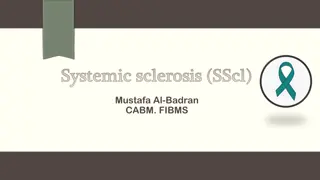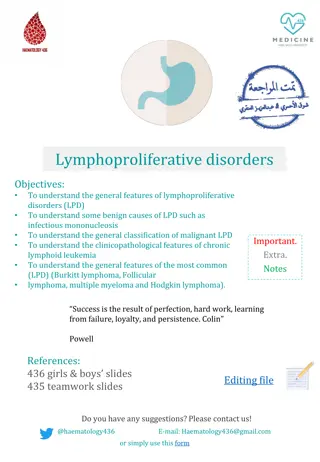Understanding Cyanosis: Causes, Types, and Clinical Differentiation
Cyanosis is characterized by a bluish discoloration of the skin and mucous membranes due to increased levels of reduced hemoglobin. This condition can be categorized as central or peripheral cyanosis, each with distinct characteristics and causes. Central cyanosis results from decreased oxygen saturation in arterial blood, while peripheral cyanosis is often associated with factors like vasoconstriction and decreased peripheral blood flow. Clinical differentiation between the two types can sometimes be complex, especially in certain medical conditions. Understanding the mechanisms and clinical classifications of cyanosis is crucial for accurate assessment and management.
Download Presentation

Please find below an Image/Link to download the presentation.
The content on the website is provided AS IS for your information and personal use only. It may not be sold, licensed, or shared on other websites without obtaining consent from the author. Download presentation by click this link. If you encounter any issues during the download, it is possible that the publisher has removed the file from their server.
E N D
Presentation Transcript
Cyanosis bluish color of the skin and mucous membranes resulting from an increased quantity of reduced hemoglobin, or of hemoglobin derivatives, in the small blood vessels of those areas. It is usually most marked in the lips, nail beds, ears, and malar eminences .cyanosis becomes apparent when the concentration of reduced hemoglobin in capillary blood exceeds 40 g/L (4 g/dL).
central cyanosis can be detected reliably when the SaO2has fallen to 85%; in others, particularly in dark-skinned persons, it may not be detected until it has declined to 75%. In the latter case, examination of the mucous membranes in the oral cavity and the conjunctivae rather than examination of the skin is more helpful in the detection of cyanosis.
Mechanism of Cyanosis Absolute increase of amount of reduced hemoglobin in blood, > 40g/L (4g/dl)(capillary) Nonfunctional hemoglobin such as methemoglobinor sulfhemoglobin) is present in blood.
Clinical Classification & Etiology True Cyanosis (increased amount of reduced Hb) Central Type Peripheral Type Mixed Type Cyanosis due to abnormal Hb derivatives Methemoglobinemia Sulfhemoglobinemia
1-Central cyanosis is caused by decreased SaO2(increased amount of reduced Hb) and the mucous membranes and skin are both affected .only occurs when the oxygen saturation of arterial blood is less than 85%.
Peripheral cyanosis is due to a slowing of blood flow and abnormally great extraction of O2from normally saturated arterial blood. It results from vasoconstriction and diminished peripheral blood flow, such as occurs in cold exposure, shock, congestive failure, and peripheral vascular disease. Often in these conditions, the mucous membranes of the oral cavity or those beneath the tongue may be spared.
Clinical differentiation between central and peripheral cyanosis may not always be simple, and in conditions such as cardiogenic shock with pulmonary edema there may be a mixture of both types
Causes of Cyanosis Central Cyanosis Decreased arterial oxygen saturation Decreased atmospheric pressure high altitude Impaired pulmonary function Alveolar hypoventilation Impaired oxygen diffusion Anatomic shunts Certain types of congenital heart disease Pulmonary arteriovenous fistulas Multiple small intrapulmonary shunts Hemoglobin with low affinity for oxygen Hemoglobin abnormalities ( Methemoglobinemia hereditary, acquired Sulfhemoglobinema acquired Carboxyhemoglobinemia (not true cyanosis)
Peripheral Cyanosis(Peripheral cyanosis is due to poor peripheral circulation and increased oxygen consumption in peripheral tissue. Reduced cardiac output Cold exposure Redistribution of blood flow from extremities Arterial obstruction Venous obstruction
Possible clinical features include ----peripheral cyanosis Cool skin and mucous membrance Site (lower extremities,fingers) Diminish after massage
Possible clinical features include ----central cyanosis the warm mucous membranes are blue, for example the tongue, the inside of the lips central cyanosis increases immediately on exercise which is not the case for peripheral cyanosis there is polycythaemia with an abnormally high haemoglobin and haematocrit clubbing is often seen in patients with central cyanosis
Differentiation of central as opposed to peripheral Cyanosis Skin temp. Massage or warming Central Warm No change Peripheral Cool Cyanosis fades
Approach to the Patient: Cyanosis Certain features are important in arriving at the cause of cyanosis: 1. It is important to know the time of onset of cyanosis. Cyanosis present since birth or infancy is usually due to congenital heart disease. 2. Central and peripheral cyanosis must be differentiated. Evidence of disorders of the respiratory or cardiovascular systems are helpful. Massage or gentle warming of a cyanotic extremity will increase peripheral blood flow and abolish peripheral, but not central, cyanosis. 3. The presence or absence of clubbing of the digits (see below) should be ascertained. The combination of cyanosis and clubbing is frequent in patients with congenital heart disease and right-to-left shunting, and is seen occasionally in patients with pulmonary disease such as lung abscess or pulmonary arteriovenous fistulae. In contrast, peripheral cyanosis or acutely developing central cyanosis is not associated with clubbed digits. 4.,spectroscopic examination of the blood performed to look for abnormal types of hemoglobin (critical in the differential diagnosis of cyanosis

















































